
In this VFR - GPS Flight Plan we take off from the airport of Abu Simbel (HEBL) [Egypt], fly southwards entering Sudan and following the course of the Nile, and land in the airport of Dongola (HSDN) [Sudan].
At the bottom of this page you will find the download link of this Flight Plan (.PLN file)

In this VFR - GPS Flight Plan we take off from
the airport of Abu Simbel (HEBL) [Egypt], fly southwards entering Sudan and following the course
of the Nile, and
land in the airport of Dongola (HSDN) [Sudan].
Find below a short extract and screenshots of the main points of the route. In this journey around Africa I have used the Cessna 172S (Skyhawk)

Taking off from the airport of Abu
Simbel, before turning southwards to the close Sudan border.
Abu Simbel Airport (IATA: ABS, ICAO: HEBL) is a regional airport in Abu Simbel, Egypt. In 2011, it served 119,326 passengers. (*1)

Entering Sudan. The lake Nasser extends into the Sudanese territory, but
Sudanese prefer to call their smaller body of water Lake Nubia.

Upon reaching the southern end of the lake, we continue by the
course of the Nile.

Here in Sudan there are also crops on the banks of the river, but much less
extensive than in Egypt.

Passing by Abri.
Abri is a small town, in the Sudanese wilayat of the Northern state. It is on the river bank of the Nile, and it lies near the second cataract that is now submerged by Lake Nasser. Its population is estimated to be about 40,000 residents.
The next major settlement upriver is the town of Delgo, Sudan, 105 km South. (*1)
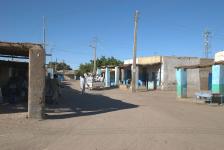 |
||
|
Abri, center of town By Bertramz - CC BY-SA 3.0 |

Overflying the 3rd cataract of the Nile, near to Tombus. The 1st and 2nd are now submerged by
the lake Nasser and the Aswan Dam.
Geologists indicate that the region of northern Sudan is tectonically active and this activity has caused the river to take on "youthful" characteristics. The Nubian Swell has diverted the river's course to the west, while keeping its depth shallow and causing the formation of the cataracts. Even as the river bed is worn down by erosion, the landmass is lifted, keeping parts of the river bed exposed. These distinctive features of the river between Aswan and Khartoum have led to the stretch being often referred to as the Cataract Nile, while the downstream portion is occasionally referred to as the "Egyptian" Nile. The geological distinction between these two portions of the river is considerable. North of Aswan, the river bed is not rocky, but is instead composed of sediment, and far from being a shallow river. It is believed that the bedrock was previously eroded to be several thousand feet deep. This created a vast canyon that is now filled with sediment.
Despite these characteristics, some of the cataracts which are normally impassable by boat because of the shallow water have become navigable during the flood season. (*1)
 |
||
| Third Cataract By Clemens Schmillen - CC BY-SA 4.0 |

Leaving Tombus behind.
Tombos or Tumbus is an archaeological site and an island in northern Sudan. The village and the island are located at the third cataract of the Nile, not far from Kerma near the present Karmah.
A large range of pharaonic and private rock inscriptions were carved at Tombos during the Eighteenth Dynasty of Egypt when the site marked an important boundary between Nubian and Egyptian interaction.
An important black granite quarry was located at Tombos in the pharaonic era. Its stone was used mostly to build statues and buildings between the river delta and the southern regions of the kingdom. Its most prominent feature is a statue of a pharaoh of the Twenty-fifth Dynasty of Egypt, abandoned for over 2700 years.
In 1991, a survey of the University of Khartoum revealed the remains of an important Egyptian colonial cemetery of New Kingdom date. In 2000, Stuart Tyson Smith of the University of California, Santa Barbara and his team excavated the remains of a pyramid more than 3,500 years old, and the buried remains of an Egyptian colonial administrator named Siamun and his mother, Weren. The two intact mummies were buried with ushabti figurines, a boomerang, and painted Mycenaean terracotta. The burial chamber includes a series of rooms, some plundered by thieves, while others were undisturbed in whole or in part. Also, an epigraphic survey by the British Museum uncovered pharaonic rock-inscriptions. (*1)
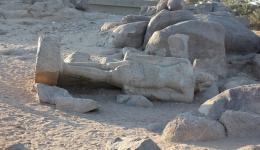 |
||
| Incomplete statue in quarry By Clemens Schmillen - CC BY-SA 4.0 |

Approaching Kerma
Kerma was the capital city of the Kerma culture, which was located in present-day Sudan at least 5500 years ago. Kerma is one of the largest archaeological sites in ancient Nubia. It has produced decades of extensive excavations and research, including thousands of graves and tombs and the residential quarters of the main city surrounding the Western/Lower Deffufa.
Around 3000 BC, a cultural tradition began around Kerma. It was a large urban center that was built around a large adobe temple known as the Western Deffufa.
As a capital city and location of royal burials, it sheds light on the complex social structure present in this society.
Kerma contains a cemetery with over 30,000 graves. The cemetery shows a general pattern of larger graves ringed by smaller ones, suggesting social stratification. The site includes at its southern boundary burial mounds, with four extending upwards of 90 metres (300 feet) in diameter. These are believed to be the graves of the city's final kings, some of which contain motifs and artwork reflecting Egyptian deities such as Horus. Generally, influence from Egypt may be observed in numerous burials, especially with regards to material evidence such as pottery and grave goods. For example, Second Intermediate Egyptian ceramics from Avaris, such as Tell el-Yahudiyeh Ware, have been discovered within Kerma burials.In addition, artifacts such as scarab seals and amulets are prolific, indicating extensive trade with ancient Egypt as well as an exchange of cultural ideas.After the sacking of Kerma, the cemetery was used to host the kings of the 25th or "Napatan" dynasty of the Kingdom of Kush from Upper (Southern) Nubia. (*1)
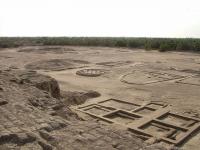 |
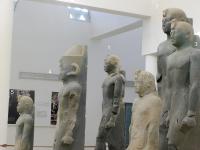 |
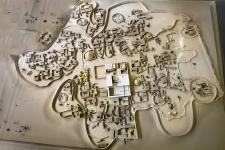 |
| Kerma ancient city By Lassi - CC BY-SA 4.0 |
Statues of pharaohs discovered near
Kerma, displayed in the Kerma Museum By Jac Strijbos8 - CC BY-SA 3.0 |
Model of the
city of Kerma c. 2000 BC, National Museum of Sudan By Matthias Gehricke - CC BY-SA 4.0 |

Final approach to the airport of Dongola
Dongola (Arabic: دنقلا, romanized: Dunqulā), also spelled Dunqulah, is the capital of the state of Northern Sudan, on the banks of the Nile, and a former Latin Catholic bishopric (14th century). It should not be confused with Old Dongola, an ancient city located 80 km upstream on the opposite bank.
Dongola was a province of Upper Nubia on both sides of the Nile, and the city was a centre for Nubian civilization, as manifested by its many archaeological remains from the Makurian and Islamic periods. Dongolawis originate from early indigenous Nubian Sub Saharan African inhabitants with many taking pride in their mostly non-mixed ancestry; although always faced with criticism this helped preserve the Nilo Saharan Dongolawi Nubian language (known as Rutana); however, cultural preferences are slowly changing. The remains of the revered Baqt Treaty are to be found in Dongola. The province of Dongola was part of the Makuria kingdom, which later became part of Egypt after Muhammad Ali Pasha ordered the invasion and occupation of Sudan in 1820; after which it was designated as a seat of a pasha. Its first governor was Abidin Bey.
Dongola was the scene of a victory by General Herbert Kitchener over the indigenous Mahdist Muslim tribes in 1899 who later turned it into a British-Egyptian army base with the objective of collecting and storing weapons, gear and resources. Dongola was a considered an all time base for sending campaign reports to Britain, and the first English press release was issued in the name of Dongola Star, with news of the British-Egyptian army in Sudan. Kitchener's forces were known for their mercilessness, killing over 15,000 Mahdist troops in the Battle of Omdurman before conquering Dongola, and later on proceeded to kill the wounded, raising the overall death toll to over 50,000.
Dongola Road and Dongola Avenue in the Bishopston area of Bristol were named after this event; as was Dongola Road in Tottenham, North London which runs next to Kitchener Road. There is also a Dongola Road in Jersey (Channel Islands). There is a Dongola Road, in Plaistow, East London. In the United States, Dongola, Illinois was established in the 1850s, and named for Dongola.There is also a Dongola Lane in Shakopee, Minnesota, and a Dongola Hwy. in Conway, South Carolina. (*1)
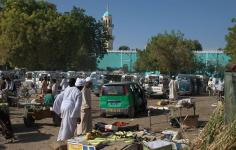 |
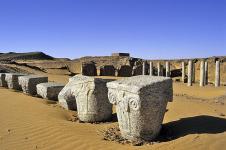 |
|
|
Dongola Market By Bertramz - CC BY 3.0 |
Church of the Granite Columns By Udimu - CC BY 2.0 |
You can download for free this Flight Plan but only for your own private use. It is strictly forbidden to share it or publish it in other sites, forums, newsgroups or in any other way . You are encouraged to share and publish links to this page only, but not direct links to the file itself.
(*1) Credits: The descriptive texts are mainly an excerpt of those provided by Wikipedia. Visit Wikipedia to read the full descriptions.
See other MS Flight Simulator flight plans and instructions
Disclaimer: These instructions and flight plan are intended to be used only for MS Flight Simulator and should not be used for real flights.